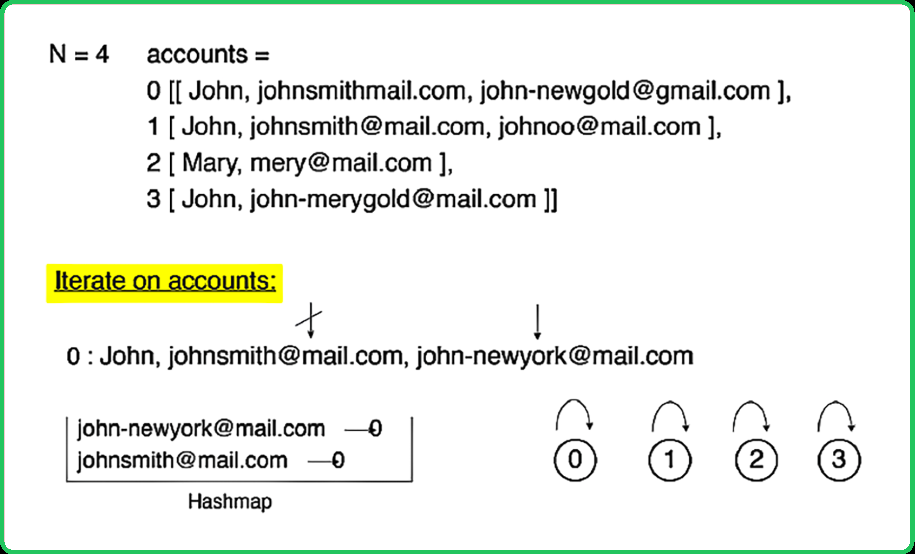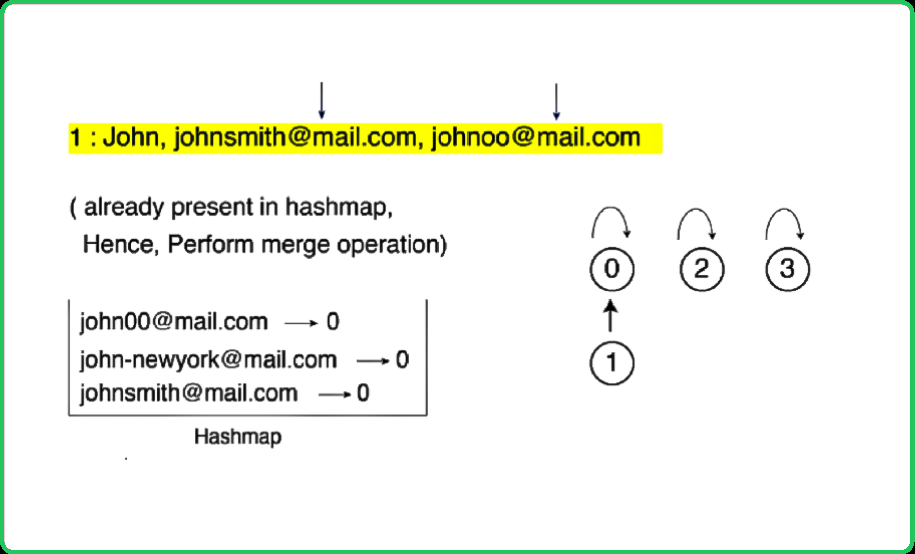123456789101112131415161718192021222324252627282930313233343536373839404142434445464748495051525354555657585960616263646566676869707172737475767778798081828384858687888990919293949596979899100101102103104105106107108109110111112113114115116117118119120121122123124125126127128129130131132133134135136137138139140141142143144145146147148149150151152153154155156157158159160161162163164165166167168169170171172
#include <bits/stdc++.h>
using namespace std;
class DisjointSet {
public:
/* To store the ranks, parents and
sizes of different set of vertices */
vector<int> rank, parent, size;
// Constructor
DisjointSet(int n) {
rank.resize(n + 1, 0);
parent.resize(n + 1);
size.resize(n + 1);
for (int i = 0; i <= n; i++) {
parent[i] = i;
size[i] = 1;
}
}
// Function to find ultimate parent
int findUPar(int node) {
if (node == parent[node])
return node;
return parent[node] = findUPar(parent[node]);
}
// Function to implement union by rank
void unionByRank(int u, int v) {
int ulp_u = findUPar(u);
int ulp_v = findUPar(v);
if (ulp_u == ulp_v) return;
if (rank[ulp_u] < rank[ulp_v]) {
parent[ulp_u] = ulp_v;
}
else if (rank[ulp_v] < rank[ulp_u]) {
parent[ulp_v] = ulp_u;
}
else {
parent[ulp_v] = ulp_u;
rank[ulp_u]++;
}
}
// Function to implement union by size
void unionBySize(int u, int v) {
int ulp_u = findUPar(u);
int ulp_v = findUPar(v);
if (ulp_u == ulp_v) return;
if (size[ulp_u] < size[ulp_v]) {
parent[ulp_u] = ulp_v;
size[ulp_v] += size[ulp_u];
}
else {
parent[ulp_v] = ulp_u;
size[ulp_u] += size[ulp_v];
}
}
};
// Solution class
class Solution{
public:
// Function to marge the accounts
vector<vector<string>> accountsMerge(vector<vector<string>> accounts){
int n = accounts.size(); // Number of accounts
// Disjoint Set data structure
DisjointSet ds(n);
// Hashmap to store the pair: {mails, node}
unordered_map<string, int> mapMailNode;
// Iterate on all the accounts
for (int i=0; i < n; i++) {
// Iterate on all the mails of the person
for (int j = 1; j < accounts[i].size(); j++) {
// Get the mail
string mail = accounts[i][j];
// If this mail was not already existing
if (mapMailNode.find(mail) ==
mapMailNode.end()) {
// Add it to the hashmap
mapMailNode[mail] = i;
}
/* Otherwise join it with
the previous component */
else {
// Unite the components
ds.unionBySize(i, mapMailNode[mail]);
}
}
}
// To store the merged mails
vector<string> mergedMail[n];
// Iterate on the Hashmap
for (auto it : mapMailNode) {
string mail = it.first; // Mail
int node = ds.findUPar(it.second); // Node
// Add the merged mail to the list
mergedMail[node].push_back(mail);
}
// To return the result
vector<vector<string>> ans;
// Iterate on all list of merged mails
for (int i = 0; i < n; i++) {
/* If a person has no mails,
skip the iteration */
if (mergedMail[i].size() == 0)
continue;
// Otherwise, add all the merged mails of person
sort(mergedMail[i].begin(), mergedMail[i].end());
vector<string> temp;
temp.push_back(accounts[i][0]);
for (auto it : mergedMail[i]) {
temp.push_back(it);
}
ans.push_back(temp);
}
sort(ans.begin(), ans.end());
return ans;
}
};
int main() {
int n = 4;
vector<vector<string>> accounts = {
{"John","johnsmith@mail.com","john_newyork@mail.com"},
{"John","johnsmith@mail.com","john00@mail.com"},
{"Mary","mary@mail.com"},
{"John","johnnybravo@mail.com"}
};
// Creating instance of Solution class
Solution sol;
// Function call to merge the accounts
vector<vector<string>> ans;
ans = sol.accountsMerge(accounts);
// Output
cout << "The mareged accounts are:\n";
for(int i=0; i < ans.size(); i++) {
for(int j = 0; j < ans[i].size(); j++) {
cout << ans[i][j] << " ";
}
cout << endl;
}
return 0;
}
123456789101112131415161718192021222324252627282930313233343536373839404142434445464748495051525354555657585960616263646566676869707172737475767778798081828384858687888990919293949596979899100101102103104105106107108109110111112113114115116117118119120121122123124125126127128129130131132133134135136137138139140141142143144145146147148149150151152153154155156157
import java.util.*;
class DisjointSet {
/* To store the ranks, parents and
sizes of different set of vertices */
int[] rank, parent, size;
// Constructor
DisjointSet(int n) {
rank = new int[n + 1];
parent = new int[n + 1];
size = new int[n + 1];
for (int i = 0; i <= n; i++) {
parent[i] = i;
size[i] = 1;
}
}
// Function to find ultimate parent
int findUPar(int node) {
if (node == parent[node])
return node;
return parent[node] = findUPar(parent[node]);
}
// Function to implement union by rank
void unionByRank(int u, int v) {
int ulp_u = findUPar(u);
int ulp_v = findUPar(v);
if (ulp_u == ulp_v) return;
if (rank[ulp_u] < rank[ulp_v]) {
parent[ulp_u] = ulp_v;
}
else if (rank[ulp_v] < rank[ulp_u]) {
parent[ulp_v] = ulp_u;
}
else {
parent[ulp_v] = ulp_u;
rank[ulp_u]++;
}
}
// Function to implement union by size
void unionBySize(int u, int v) {
int ulp_u = findUPar(u);
int ulp_v = findUPar(v);
if (ulp_u == ulp_v) return;
if (size[ulp_u] < size[ulp_v]) {
parent[ulp_u] = ulp_v;
size[ulp_v] += size[ulp_u];
}
else {
parent[ulp_v] = ulp_u;
size[ulp_u] += size[ulp_v];
}
}
}
// Solution class
class Solution {
// Function to merge the accounts
static List<List<String>> accountsMerge(List<List<String>> accounts) {
int n = accounts.size(); // Number of accounts
// Disjoint Set data structure
DisjointSet ds = new DisjointSet(n);
// Hashmap to store the pair: {mails, node}
Map<String, Integer> mapMailNode = new HashMap<>();
// Iterate on all the accounts
for (int i = 0; i < n; i++) {
// Iterate on all the mails of the person
for (int j = 1; j < accounts.get(i).size(); j++) {
// Get the mail
String mail = accounts.get(i).get(j);
// If this mail was not already existing
if (!mapMailNode.containsKey(mail)) {
// Add it to the hashmap
mapMailNode.put(mail, i);
}
/* Otherwise join it with
the previous component */
else {
// Unite the components
ds.unionBySize(i, mapMailNode.get(mail));
}
}
}
// To store the merged mails
List<List<String>> mergedMail = new ArrayList<>(n);
for (int i = 0; i < n; i++) {
mergedMail.add(new ArrayList<>());
}
// Iterate on the Hashmap
for (Map.Entry<String, Integer> entry : mapMailNode.entrySet()) {
String mail = entry.getKey(); // Mail
int node = ds.findUPar(entry.getValue()); // Node
// Add the merged mail to the list
mergedMail.get(node).add(mail);
}
// To return the result
List<List<String>> ans = new ArrayList<>();
// Iterate on all list of merged mails
for (int i = 0; i < n; i++) {
/* If a person has no mails,
skip the iteration */
if (mergedMail.get(i).isEmpty())
continue;
// Otherwise, add all the merged mails of person
Collections.sort(mergedMail.get(i));
List<String> temp = new ArrayList<>();
temp.add(accounts.get(i).get(0));
temp.addAll(mergedMail.get(i));
ans.add(temp);
}
ans.sort(Comparator.comparing(list -> list.get(0)));
return ans;
}
public static void main(String[] args) {
int n = 4;
List<List<String>> accounts = Arrays.asList(
Arrays.asList("John","johnsmith@mail.com","john_newyork@mail.com"),
Arrays.asList("John","johnsmith@mail.com","john00@mail.com"),
Arrays.asList("Mary","mary@mail.com"),
Arrays.asList("John","johnnybravo@mail.com")
);
// Function call to merge the accounts
List<List<String>> ans = accountsMerge(accounts);
// Output
System.out.println("The merged accounts are:");
for (List<String> account : ans) {
System.out.println(String.join(" ", account));
}
}
}
123456789101112131415161718192021222324252627282930313233343536373839404142434445464748495051525354555657585960616263646566676869707172737475767778798081828384858687888990919293949596979899100101102103104105106107108109110111112113114115116117118119120
class DisjointSet:
# To store the ranks, parents and
# sizes of different set of vertices
def __init__(self, n):
self.rank = [0] * (n + 1)
self.parent = list(range(n + 1))
self.size = [1] * (n + 1)
# Function to find ultimate parent
def findUPar(self, node):
if node == self.parent[node]:
return node
self.parent[node] = self.findUPar(self.parent[node])
return self.parent[node]
# Function to implement union by rank
def unionByRank(self, u, v):
ulp_u = self.findUPar(u)
ulp_v = self.findUPar(v)
if ulp_u == ulp_v: return
if self.rank[ulp_u] < self.rank[ulp_v]:
self.parent[ulp_u] = ulp_v
elif self.rank[ulp_v] < self.rank[ulp_u]:
self.parent[ulp_v] = ulp_u
else:
self.parent[ulp_v] = ulp_u
self.rank[ulp_u] += 1
# Function to implement union by size
def unionBySize(self, u, v):
ulp_u = self.findUPar(u)
ulp_v = self.findUPar(v)
if ulp_u == ulp_v: return
if self.size[ulp_u] < self.size[ulp_v]:
self.parent[ulp_u] = ulp_v
self.size[ulp_v] += self.size[ulp_u]
else:
self.parent[ulp_v] = ulp_u
self.size[ulp_u] += self.size[ulp_v]
# Solution class
class Solution:
# Function to merge the accounts
def accountsMerge(self, accounts):
n = len(accounts) # Number of accounts
# Disjoint Set data structure
ds = DisjointSet(n)
# Hashmap to store the pair: {mails, node}
mapMailNode = {}
# Iterate on all the accounts
for i in range(n):
# Iterate on all the mails of the person
for j in range(1, len(accounts[i])):
# Get the mail
mail = accounts[i][j]
# If this mail was not already existing
if mail not in mapMailNode:
# Add it to the hashmap
mapMailNode[mail] = i
# Otherwise join it with the previous component
else:
# Unite the components
ds.unionBySize(i, mapMailNode[mail])
# To store the merged mails
mergedMail = [[] for _ in range(n)]
# Iterate on the Hashmap
for mail, node in mapMailNode.items():
root = ds.findUPar(node)
mergedMail[root].append(mail)
# To return the result
ans = []
# Iterate on all list of merged mails
for i in range(n):
# If a person has no mails, skip the iteration
if not mergedMail[i]:
continue
# Otherwise, add all the merged mails of person
mergedMail[i].sort()
temp = [accounts[i][0]] + mergedMail[i]
ans.append(temp)
ans.sort()
return ans
if __name__ == "__main__":
n = 4
accounts = [
["John","johnsmith@mail.com","john_newyork@mail.com"],
["John","johnsmith@mail.com","john00@mail.com"],
["Mary","mary@mail.com"],
["John","johnnybravo@mail.com"]
]
# Creating instance of Solution class
sol = Solution()
# Function call to merge the accounts
ans = sol.accountsMerge(accounts)
# Output
print("The merged accounts are:")
for account in ans:
print(" ".join(account))
123456789101112131415161718192021222324252627282930313233343536373839404142434445464748495051525354555657585960616263646566676869707172737475767778798081828384858687888990919293949596979899100101102103104105106107108109110111112113114115116117118119120121122123124125126127128129130131132133134135
class DisjointSet {
/* To store the ranks, parents and
sizes of different set of vertices */
constructor(n) {
this.rank = new Array(n + 1).fill(0);
this.parent = new Array(n + 1).fill(0).map((_, i) => i);
this.size = new Array(n + 1).fill(1);
}
// Function to find ultimate parent
findUPar(node) {
if (node === this.parent[node])
return node;
this.parent[node] = this.findUPar(this.parent[node]);
return this.parent[node];
}
// Function to implement union by rank
unionByRank(u, v) {
let ulp_u = this.findUPar(u);
let ulp_v = this.findUPar(v);
if (ulp_u === ulp_v) return;
if (this.rank[ulp_u] < this.rank[ulp_v]) {
this.parent[ulp_u] = ulp_v;
} else if (this.rank[ulp_v] < this.rank[ulp_u]) {
this.parent[ulp_v] = ulp_u;
} else {
this.parent[ulp_v] = ulp_u;
this.rank[ulp_u]++;
}
}
// Function to implement union by size
unionBySize(u, v) {
let ulp_u = this.findUPar(u);
let ulp_v = this.findUPar(v);
if (ulp_u === ulp_v) return;
if (this.size[ulp_u] < this.size[ulp_v]) {
this.parent[ulp_u] = ulp_v;
this.size[ulp_v] += this.size[ulp_u];
} else {
this.parent[ulp_v] = ulp_u;
this.size[ulp_u] += this.size[ulp_v];
}
}
}
// Solution class
class Solution {
// Function to merge the accounts
accountsMerge(accounts) {
let n = accounts.length; // Number of accounts
// Disjoint Set data structure
let ds = new DisjointSet(n);
// Hashmap to store the pair: {mails, node}
let mapMailNode = new Map();
// Iterate on all the accounts
for (let i = 0; i < n; i++) {
// Iterate on all the mails of the person
for (let j = 1; j < accounts[i].length; j++) {
// Get the mail
let mail = accounts[i][j];
// If this mail was not already existing
if (!mapMailNode.has(mail)) {
// Add it to the hashmap
mapMailNode.set(mail, i);
}
/* Otherwise join it with
the previous component */
else {
// Unite the components
ds.unionBySize(i, mapMailNode.get(mail));
}
}
}
// To store the merged mails
let mergedMail = Array.from({ length: n }, () => []);
// Iterate on the Hashmap
for (let [mail, node] of mapMailNode.entries()) {
let root = ds.findUPar(node);
mergedMail[root].push(mail);
}
// To return the result
let ans = [];
// Iterate on all list of merged mails
for (let i = 0; i < n; i++) {
/* If a person has no mails,
skip the iteration */
if (mergedMail[i].length === 0)
continue;
// Otherwise, add all the merged mails of person
mergedMail[i].sort();
let temp = [accounts[i][0], ...mergedMail[i]];
ans.push(temp);
}
ans.sort((a, b) => a[0].localeCompare(b[0]));
return ans;
}
}
let accounts = [
["John","johnsmith@mail.com","john_newyork@mail.com"],
["John","johnsmith@mail.com","john00@mail.com"],
["Mary","mary@mail.com"],
["John","johnnybravo@mail.com"]
];
// Creating instance of Solution class
let sol = new Solution();
// Function call to merge the accounts
let ans = sol.accountsMerge(accounts);
// Output
console.log("The merged accounts are:");
for (let account of ans) {
console.log(account.join(" "));
}


